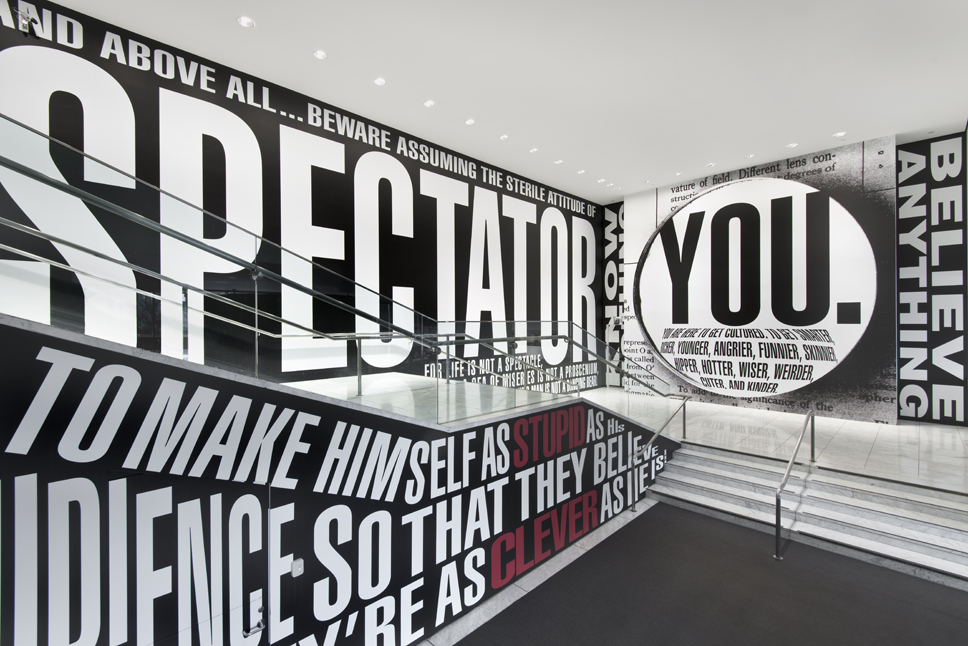Take It or Leave It: Institution, Image, Ideology
Q&A with Senior Curator Anne Ellegood
by Susannah Tantemsapya
 M Daily
April, 2014
M Daily
April, 2014 Take It or Leave It: Institution, Image, Ideology Digital Archive. Los Angeles: Hammer Museum, 2017. https://hammer.ucla.edu/take-it-or-leave-it
Take It or Leave It: Institution, Image, Ideology Digital Archive. Los Angeles: Hammer Museum, 2017. https://hammer.ucla.edu/take-it-or-leave-it
Take It or Leave It: Institution, Image, Ideology is the first, large-scale exhibition to tackle the genres of institutional critique and appropriation. Drawing from the work of 36 artists, each gallery is organized by specific themes (Representation, Politics, Media, America, Language, Interaction, Public Record, Archive) rather than by chronology. It is focused on work produced in America from the late 1970s through the early 1990s (although there is a smattering of pieces made after that period throughout the show). The feminist and civil rights movements–started by the generation before–heavily influenced this distinct period of contemporary art. M Daily spoke with Hammer senior curator Anne Ellegood about how to digest such a dense and historically relevant exhibition.
M Daily:
When did you begin working with
co-curator Johanna Burton (Keith Haring Director, Curator of Education and Public Engagement
at the New Museum) on this show? How did that come about?
co-curator Johanna Burton (Keith Haring Director, Curator of Education and Public Engagement
at the New Museum) on this show? How did that come about?
Anne Ellegood:
We began having conversations about an earlier iteration of this exhibition about seven years ago. We are close colleagues and friends, and are constantly in dialogue about art. We worked on the ideas in the exhibition over time and proposed it in its current configuration to the Hammer about a year after I started working here. We have been working in earnest on the exhibition for about three to four years.M Daily: What is the significance of its title, Take It or Leave It: Institution, Image, Ideology?
AE: It’s a colloquial phrase that we felt suited the exhibition well. It includes the act of taking something, which relates nicely to the strategy of appropriation that is a primary subject of the exhibition, but it also makes clear that to take something (to borrow or steal an image, a form, a phrase from an existing cultural source) is a choice. You can choose to take or choose not to. This suggests an active role on the part of the artist, but also, importantly, on the part of the viewer. Active, engaged viewing that leads to critical thinking is something these artists have encouraged in their work. We also liked that, take as a whole, the phrase is slightly edgy and has energy to it.
M Daily: How did you curate the pieces in order to guide the viewer through such a diverse, wide range of work?
AE:
This is a large question and not easy to summarize quickly. The process of selecting works for the exhibition was a long one that involved much discussion between me and Johanna Burton, with the artists, and then, later with lenders. We wanted, whenever possible, to include artists work over time. We also knew that there would be some new commissions, primarily the lobby wall project with Barbara Kruger. Because we selected artists who we feel have maintained critical practices over time, we realized that almost anything the artists have made during their careers could work, so it was a process at looking closely at their work over time and selecting specific works that made arguments we were interested in, that related to other works in the exhibition meaningfully, etc.
In some cases, there were specific works by artists that we knew from early on that we wanted to include. In some cases, a work might be one of the most widely known works by a particular artist—like Mary Kelly’s Post-Partum Document—that has been highly influential, and we felt strongly it needed to be included in the exhibition. In other cases, it might be an important work by an artist that is lesser known or not exhibited as frequently, like Adrian Piper’s This Is Not a Performance. We also wanted to include works that had not been exhibited in a long time—like the two 1992 works by Mark Dion that were in his first solo exhibition at American Fine Arts or Andrea Fraser’s Notes on the Margin. We were interested in works in which artists referred to another artist’s work—to point to the ways that these artists were really looking at one another’s works and were engaged in critical dialogues and pedagogy—such as Stephen Prina’s work about Felix Gonzales-Torres, Chris Williams’s work about Chris D’Arcangelo and Bas Jan Ader, and Glenn Ligon’s work about Robert Mapplethorpe. We also wanted to be sure to include works in which artists collaborated together to create the work—like the work by Robert Gober and Sherrie Levine and the work by Paul McCarthy and Mike Kelley.
In terms of the installation, we wanted to create a rhythm through what is a very dense installation. We deliberately wanted the installation to be dense… for the works to be in close dialogue with one another. But each gallery has a different feeling and a different approach. Works are sometimes group by generation of artist or art historical affinities. Sometimes they are grouped more thematically and address similar concerns through a variety of means…like “politics” or “America.” Some works—like Glenn Ligon’s Notes on the Margin of the Black Book and Paul McCarthy’s large sculpture are juxtaposed in order to both complicate and complement each other. There are a variety of approaches to how we chose to install the works and to the relationships we wanted to point to and create in and among works.
M Daily: What has been the reaction to it so far? Any surprises?
AE: The reaction has been great. It’s a complex, layered, dense exhibition. It can be a bit overwhelming. But people seem to be truly getting a lot out of the exhibition and enjoying the ride. One of the most rewarding aspects has been taking students through the show who are excited to see works that they have studies or seen reproductions of, but have never had the chance to see in-person.
It’s really up to others to decide how important the exhibition is. But there are many reasons why Johanna and I felt that doing this exhibition was important curatorially and historically. One thing about the curatorial argument is the recognition that group exhibitions that explore a particular period, or particular genres or artistic strategies, can be approached through a variety means… that different curators would do a different exhibition and we recognize that. We feel that our approach to this material is one perspective into it and that there are many other exhibitions that could be done.
Obviously, we feel deeply that these artists’ works are important and should be seen, studied, debated, and pondered. From a more broad perspective, I feel that Take It or Leave It is an important exhibition because it proposes that exhibitions can take a position, and that moreover, artists can, and should, tackle the most difficult political and cultural concerns of the moment and that art can be a catalyst for discussion and debate, and even for actual change.
M Daily: How does the opening of Take It or Leave It relate to the Hammer's new free admissions?
Take It or Leave It: Institution, Image, Ideology is on view at the Hammer Museum through May 18, 2014 and includes works by: Judith Barry, Gretchen Bender, Dara Birnbaum, Nayland Blake, Tom Burr, Mark Dion, Mark Dion & Jason Simon, Jimmie Durham, Andrea Fraser, Robert Gober, Felix Gonzalez-Torres, Renée Green, Jenny Holzer, Mike Kelley, Mary Kelly, Silvia Kolbowski, Barbara Kruger, Louise Lawler, William Leavitt, Zoe Leonard, Sherrie Levine, Glenn Ligon, Paul McCarthy, Allan McCollum, John Miller, Matt Mullican, Cady Noland, Adrian Piper, Stephen Prina, Martha Rosler, Haim Steinbach, Rirkrit Tiravanija, Christopher Williams, Sue Williams, Fred Wilson and David Wojnarowicz.